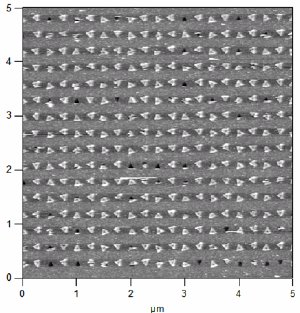Aug 17 2009
Today, scientists at IBM Research (NYSE:IBM) and the California Institute of Technology announced a scientific advancement that could be a major breakthrough in enabling the semiconductor industry to pack more power and speed into tiny computer chips, while making them more energy efficient and less expensive to manufacture.
 IBM scientists are using DNA scaffolding to build tiny circuit boards; in this image, individual triangular DNA origami are adhering to a template with properly sized triangular features. (PRNewsFoto/IBM)
IBM scientists are using DNA scaffolding to build tiny circuit boards; in this image, individual triangular DNA origami are adhering to a template with properly sized triangular features. (PRNewsFoto/IBM)
IBM Researchers and collaborator Paul W.K. Rothemund, of the California Institute of Technology, have made an advancement in combining lithographic patterning with self assembly - a method to arrange DNA origami structures on surfaces compatible with today's semiconductor manufacturing equipment.
Today, the semiconductor industry is faced with the challenges of developing lithographic technology for feature sizes smaller than 22 nm and exploring new classes of transistors that employ carbon nanotubes or silicon nanowires. IBM's approach of using DNA molecules as scaffolding -- where millions of carbon nanotubes could be deposited and self-assembled into precise patterns by sticking to the DNA molecules - may provide a way to reach sub-22 nm lithography.
The utility of this approach lies in the fact that the positioned DNA nanostructures can serve as scaffolds, or miniature circuit boards, for the precise assembly of components - such as carbon nanotubes, nanowires and nanoparticles - at dimensions significantly smaller than possible with conventional semiconductor fabrication techniques. This opens up the possibility of creating functional devices that can be integrated into larger structures, as well as enabling studies of arrays of nanostructures with known coordinates.
"The cost involved in shrinking features to improve performance is a limiting factor in keeping pace with Moore's Law and a concern across the semiconductor industry," said Spike Narayan, manager, Science & Technology, IBM Research - Almaden. "The combination of this directed self-assembly with today's fabrication technology eventually could lead to substantial savings in the most expensive and challenging part of the chip-making process."
The techniques for preparing DNA origami, developed at Caltech, cause single DNA molecules to self assemble in solution via a reaction between a long single strand of viral DNA and a mixture of different short synthetic oligonucleotide strands. These short segments act as staples - effectively folding the viral DNA into the desired 2D shape through complementary base pair binding. The short staples can be modified to provide attachment sites for nanoscale components at resolutions (separation between sites) as small as 6 nanometers (nm). In this way, DNA nanostructures such as squares, triangles and stars can be prepared with dimensions of 100 - 150 nm on an edge and a thickness of the width of the DNA double helix.
IBM uses traditional semiconductor techniques, the same used to make the chips found in today's computers, to etch out patterns, creating the lithographic templates for this new approach. Either electron beam or optical lithography are used to create arrays of binding sites of the proper size and shape to match those of individual origami structures. The template materials are chosen to have high selectivity so that origami binds only to the patterns of "sticky patches" and nowhere else.
The paper on this work, "Placement and orientation of DNA nanostructures on lithographically patterned surfaces," by scientists at IBM Research and the California Institute of Technology will be published in the September issue of Nature Nanotechnology and is currently available at: http://www.nature.com/nnano/journal/vaop/ncurrent/abs/nnano.2009.220.html.